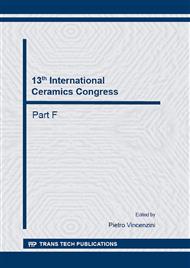p.203
p.209
p.215
p.221
p.226
p.232
p.242
p.248
p.258
Mould Fluxes Viscosity and Surface Tension Influence on the Wear Mechanisms of Al2O3-C Nozzle
Abstract:
A deep understanding of the mould flux effect on the wear mechanisms of Al2O3-C nozzles (AG) is relevant to avoid premature damage and to decrease the cost of black refractories in the industry. In this paper, a post mortem study on a nozzle was carried out to identify the causes of the wear mechanisms during the continuous casting of billets. Physical properties such as viscosity and surface tension of the mould fluxes were determined at operation temperature (1550oC), in order to correlate with microstructural results obtained by light and scanning electron microscopy (SEM). Also dihedral angle φ measurements were carried out at high magnification by SEM. Applying EDS analysis the infiltrated mould flux chemical composition was determined. The study was completed by EBSD. The EBSD technique contributed to increase the knowledge on wear mechanisms because of the possibility of identifying and localizing phases together with crystalline condition. The phases, the grain orientations and the properties of grain boundaries, have a large influence on the corrosion behaviour. Therefore, it is essential to have a characterization technique that can provide information such as: grain size, orientation, misorientation angle and the present phases. In this context, EBSD can provide relevant information on crystallographic and structural analysis of AG nozzle including the insert of ZrO2-C.
Info:
Periodical:
Pages:
226-231
Citation:
Online since:
October 2014
Authors:
Keywords:
Price:
Сopyright:
© 2014 Trans Tech Publications Ltd. All Rights Reserved
Share:
Citation:


